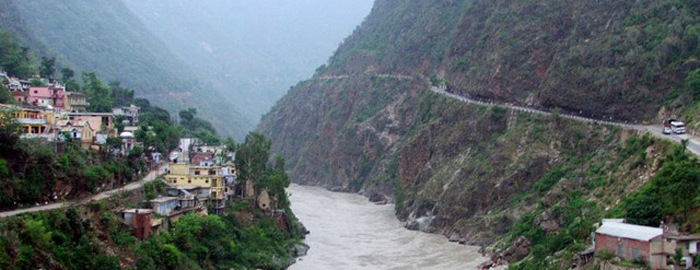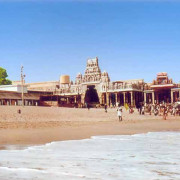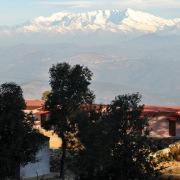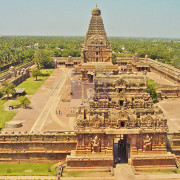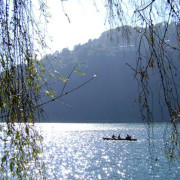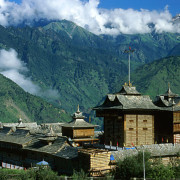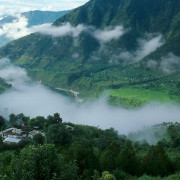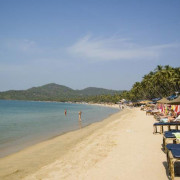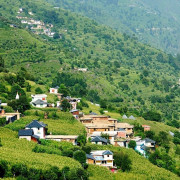Badrinath, Uttarakhand – The abode of almighty Lord Vishnu, located at 3,133 mts on the Himalayan mountain range, is a sacred place for the Hindus
Situated in the Chamoli district of Uttarakhand, Badrinath is a sacred town of the Hindus. This is the most important spot of the whole Char Dham yatra. Badrinath was established by Adi Shankaracharya in the 9th century. The town is located at an altitudeof 3,133mts above sea level on the left bank of Alakananda River. This holy town lies between Nar and Naryana mountain ranges, with the Nilkantha peak shadowing the town. According to the Bhagavata Purana, “There in Badrikashram the supreme being (Vishnu), in his incarnation as the sages Nara and Narayana, had been undergoing great penance since time immemorial for the welfare of all living entities.” The Badrinath area was known as Badari or Badarikaashram in Hindu scriptures. The name Badrinath was derived from Badari meaning ‘berries’ and Nath meaning ‘Lord of’. The mountains around Badrinath are also mentioned in the Mahabharata. The Pandavas are said to have ended their life by ascending the slopes of a peak in western Garhwal called Swargarohini – literally meaning the ‘Ascent to Heaven’. According to the local legends the Pandavas passed through Badrinath and the town of Mana, 4 km north of Badrinath, on their way to Svarga (heaven). There is also a cave in Mana where Vyasa, according to legend, wrote the Mahabharata.
Places to see in Badrinath: The major attraction of Badrinath is the famous Badrinath temple. However there are also other sight seeing locations holding great religious significance. These include:
Badrinath Temple
Badrinath is the most sacred Dham of India. It is located at an elevation of 3,133mts above sea level in the Chamoli district of Uttarakhand state. This Dham was established by Adi Shankaracharya in the 9th century. The deity of Badrinath temple is Lord Vishnu. The temple is situated on the right bank of the holy Alaknanda River. The colorful ‘Singh-Dwara’ at the entrance is very artistic creation. Every year millions of tourists and devotees visit this sacred place from May to October month. The temple remains closed during winter months as the region is prone to heavy snowfall.
Tapt Kund
Tapt Kund is a natural thermal spring where the devotees take a holy dip as it is very important to take a bath before visiting a temple. It is also believed that the kund has medicinal values and can cure allergies of the people. All the devotees take holy dip in the natural hot water together with unknown people. The people may be unknown to each other but their purpose of visit is same, i.e. to worship in the sacred Badrinath Dham.
Brahma Kapal
Brahma Kapal is a place where Hindus performs propitiating rites for their deceased ancestors. Brahma Kapal is a flat platform on the bank of river Alaknanda. You can see several pundits sitting with ‘pooja samagri’.
Neelkanth
Situated above the Badrinath Temple, Neelkanth peak is named after Lord Shiva. The cliff of the peak is the first place where the sun castes its crimson rays. Neelkanth is a Pyramidal-shaped snowy peak and if you carefully observe its cliff then you can see as if Lord Shiva is sitting looking at the sky. Neelkanth peak is situated at an elevation of 6,560mts above sea level. Numerous Brahmakal can be seen at the foot of Neelkanth Peak and the trekking route of 6km can be achieved easily.
Mata Murti Temple
Situated 3kms from Badrinath, Mata Murti Temple is dedicated to the mother of Lord Narayan. According to mythology Mata Murti prayed Lord Vishnu to take his next avatar by coming out from her womb. Lord Vishnu then happily agreed and came into world as twins, Nar and Narayan to kill a monster. Every year a fair is held in the month of August at Mata Murti Temple.
Charanpaduka
Situated 3km above Badrinath Temple lies a beautiful meadow carpeted with wild flowers in the summers. A boulder bearing the footprints of Lord Vishnu is located here known as Charanpaduka. It is said that when Lord Vishnu descended from Vaikunth he stepped on this boulder. The area is a steep climb from the town and is full of caves & boulders. This path leads you to the foot of Neelkanth peak where you can find several Brahmakamals.
Narad Kund
Located near Tapt Kund, this kund is believed to be the recovery source of the Badarinath idol. The hot water springs comes out from beneath the Garur Shila and falls into a tank. Darshan of Badarinath is always preceded by a holy dip in this kund. Apart from that there are many other hot water springs. Devotees take a dip in them for their religious and medicinal value.
Mana
Mana is very close to Tibet border and it is one of the last villages of India. Most of the tourists who visit Badrinath also come to see the end of the road at Mana. Mana is inhabited by Indo-Mongolian tribes often called as bhotias. Mana is situated 3kms from Badrinath.
Bheem Pul
Bheem Pul is an enthralling and adventurous place with mythological importance. This is the place where Bheem threw a big massif rock to make a path joining two mountains so that Draupadi could walk easily on it. Saraswati River is coming from between the mountain with immense force to merge with the water of Alanknanda River.
Vyas Cave
Vyas Gufa or Vyas Cave is the place from where Ved Vyas dictated entire Mahabharata to God Ganesha so that he could write. Ved Vyas also meditated in this cave
Ganesha Cave
Ganesha Cave is the natural cave where he wrote Mahabharata as dictated by Ved Vyas from Vyas Gufa.
Sheshnetre
On the opposite bank of the river Alaknanda, in the lap of Nar Parvat, there are two small seasonal lakes. Between these lakes is a boulder having an impression of the legendary snake, Sheshnag. The formation of eye on the boulder is natural.
Panch Dharas & Panch Shilas
The Panch Dharas (five streams) which are famous in Badaripuri are Prahlad, Kurma, Bhrigu, Urvashi & Indira dhara. The most striking of these is the Indira dhara, about 1.5 km north of the town Badaripuri. Around the Tapt Kund there are five blocks of mythological importance called Narad, Narsimh, Barah, Garur & Markandeya Shilas (stone).
Nearby attractions around Badrinath: The pristine town of Badrinath is also dotted with some nearby attractions. These include:
Vasudhara Falls
It can be reached by a short and easy trek of 4km from Mana Village. Vasudhara falls is 400 feet high and it is set at an elevation of 12,000feet above sea level. It is believed that the scattered drops of the waterfall don’t falls on the sinners. If you see the waterfall from distance it will look like as if milk is falling from the mountain.
Satopanth
Satopanth Lake holds immaculate and pristine water and it it believed that Bheema was denied to enter heaven from this very point. Satopanth is the place which leads the path to Swargarohini peak from where Yudhishthir and the dog were sent to heaven according to the Mahabharata. The trek to Satopanth is moderate and there are no villages and rest houses, people generally sleep in caves and tents here. The route to Satopanth Sarovar blesses the individuals with nature’s beauteousness.
Pandukeshwar
This place is believed to have been established by King Pandu, father of Pandavas. It is situated at 4 kms from Govind Ghat, 219 kms from Kedarnath and 24 kms from Badarinath. There are two temples – one for Lord Yoga Badari Narayan and the other for Lord Vasudev. During winter, Lord Vasudev temple functions as the abode for Lord Badari Narayan and all the daily rituals connected with worship are performed here. Both the temples are centuries old.
Joshimath
Joshimath is one of the four ‘math‘ created by Adi Shankaracharya. Joshimath is the home of Shri Badrinath during winters. Joshimath is connected with Auli by highest cable car of Asia. Joshimath is situated at an elevation of 1,890mts above sea level. Do visit Kalpavriksha and Narsingh temple while a visit to Joshimath. It is situated 46kms from Badrinath.
Auli
Auli is the most popular skiing and paragliding spot of Uttarakhand situated at an elevation of 3050mts above sea level. Auli affords astounding and celestial views of the enchanting snow laden Himalayan range. Asia’s highest and longest cable car is situated in Auli connecting it with Joshimath. Auli is also connected with motorable roads, situated 60kms from Badrinath.
Valley of Flowers
Valley of Flowers National Park is nestled in the west Himalayas covering an area of 87.50sqkms. The trek of 16km to Valley of Flowers commences from Govindghat. The valley is entirely covered with blooming flowers from June to October and with the sheets of snow during winters. The valley of flowers was declared as the national park in the year 1982 and it is now a world heritage site. The virgin beauty of this valley lures the botanists, nature lovers and adventure lovers as well.
Hemkund Sahib
The tenth Guru of the Sikhs, Guru Govind Singhji mediated at Hemkund Sahib for years. The word Hemkund literally suggests ‘Lake of snow’ and the immaculate water of this lake is as cold as snow. Hemkund Saheb is located at an elevation of 4,329mts above sea level amidst several snow capped peaks, which are collectively called Hemkund Parvat. A star shaped gurudwara near the lake is visited by thousands of devotees every month. A temple dedicated to Lakshman, brother of Lord Rama is also located here. One must complete a trek of 19km starting from from Govindghat via Ghangaria to reach Hemkund Sahib.
Adi Badari
The main Temple is of the lord Narayan that is distinguished by a raised platform in the pyramidal form. Here a black stone idol of lord Vishnu is enshrined. Local tradition attributes the building of the temples to Adi Guru Shankaracharya. It is situated at a distance of 17 Kms from Karnaprayag and is easily approachable by motorable road.
Things to do in Badrinath: This pristine location offers abundant activities for the tourists. After paying homage to the supreme Lord Badrinath, you can enjoy sight seeing to some nearby locations. The shopping lovers can buy local products available in the markets which includes handicrafts items, wooden toys and also many other unique products. If doing nothing just open the window of your guest house and stare on the spectacular snowy mountain range. This abode of Lord Vishnu (Badrinath) gives a completely different feeling as you keep your first step upon this divine step.
Best time to visit Badrinath: The peak visiting season is from May to November. However due to heavy monsoon the visitors may face difficulty to reach the temple during monsoon (late June to Aug).
How to go ?
By Air
Jolly Grant Airport in Dehradun is the nearest airport to Badrinath. It is a domestic airport 326 km away from Badrinath. Nearest International airport is New Delhi (491 km), which is well connected to all major cities in India and most of the major foreign cities too.
By Train
Rishikesh (nearly 283 km), Haridwar (nearly 305 km) and Kotdwar (nearly 330 km) are the nearest railway stations. These railway stations are well connected to other cities in India.
By Road
There are many public and private buses from New Delhi, Rishikesh and Haridwar. Special tourist daily buses are also available from these places to Badrinath.
Where to stay ?
The location provides an array of accommodation facilities. Some options are:
Devlok Tourist Bungalow (GMVN): +91–01381-222212
Sarovar Portico: 093103 33317
Sree Sree Balananda Tirthashram: +91-01381-222254
Hotel Dwarikesh: www.hoteldwarikesh.in
Note : Phone numbers given above are according to the information available with us. If you find any contact number/s given above is/are incorrect or not in use, please let us know.

